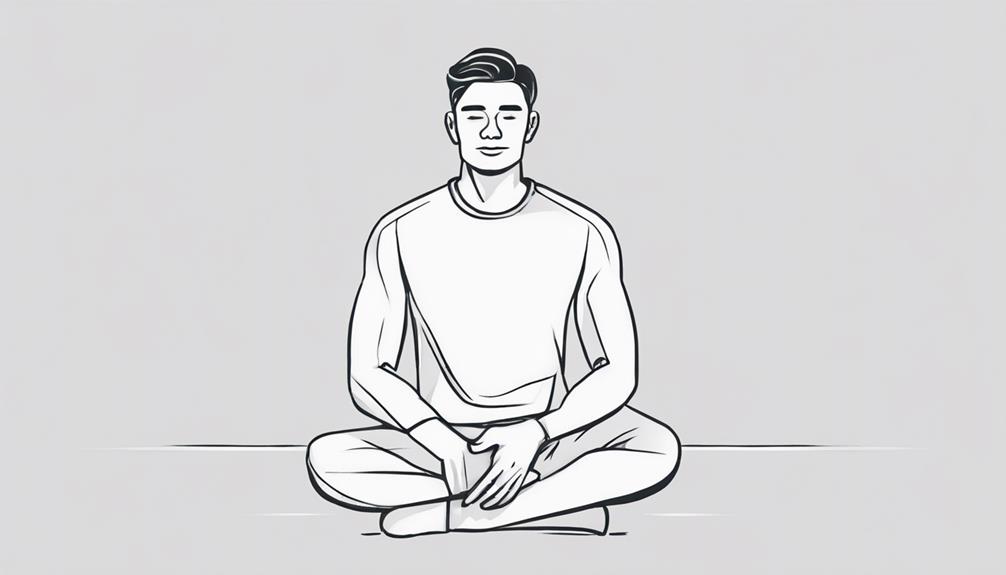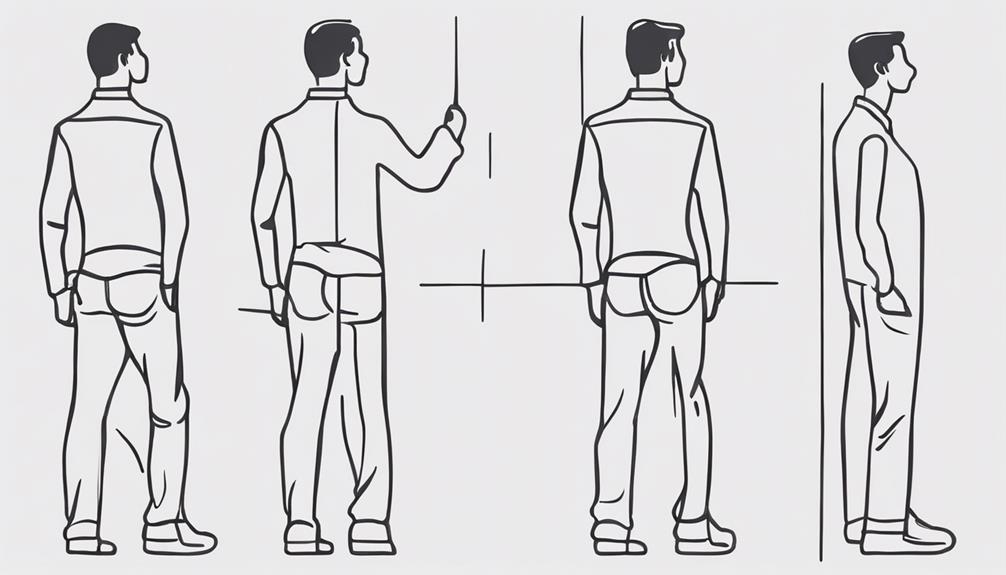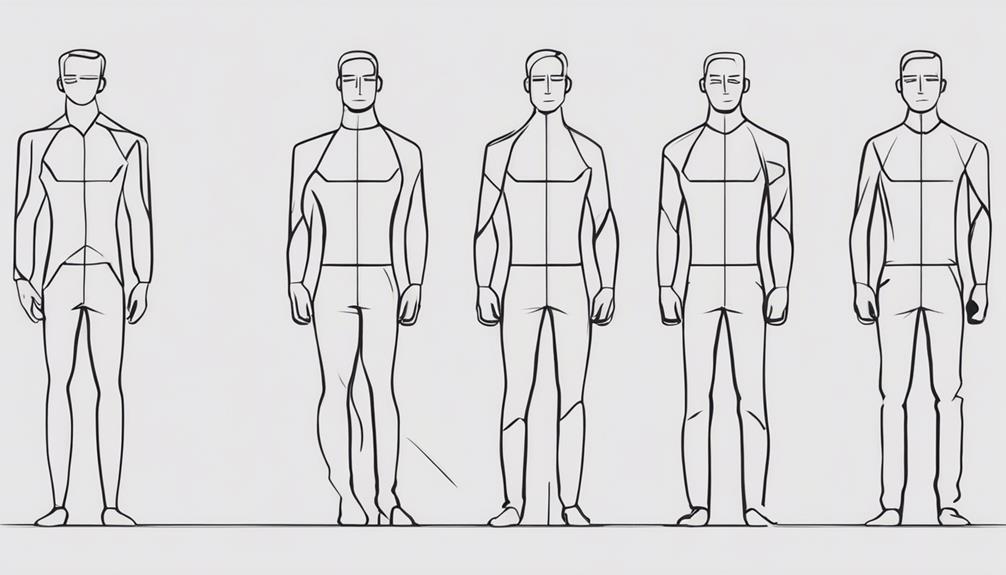Maintaining good posture is not merely about appearances; it is a fundamental aspect of physical well-being. The alignment of the body plays a key role in supporting muscles and joints, reducing the risk of pain and discomfort, and ensuring optimal organ function. However, the significance of good posture extends beyond the physical realm. Join me as we explore the far-reaching benefits of maintaining proper posture and how it can positively impact various facets of our lives.
Key Takeaways
- Good posture reduces musculoskeletal risks and enhances overall health.
- Proper posture prevents injuries, improves workout effectiveness, and boosts confidence.
- Maintaining correct posture aligns the spine, supports lung capacity, and prevents back pain.
- Seek professional guidance for personalized posture correction and early intervention for optimal results.
Benefits of Good Posture

Good posture yields numerous benefits that positively impact physical health and overall well-being. Maintaining proper posture plays a crucial role in reducing the risk of various musculoskeletal issues, particularly in the back. By aligning the spine correctly, good posture helps distribute the body's weight more evenly, which decreases the strain on muscles and joints in the back. This alignment reduces the risk of developing conditions such as low back pain, a prevalent issue affecting a significant portion of the working population annually.
Furthermore, good posture contributes to muscle health by reducing tension and promoting proper alignment. When the body is correctly positioned, the muscles in the neck and back can function optimally, decreasing the likelihood of experiencing discomfort or pain. By minimizing muscle tension, good posture also aids in reducing the occurrence of tension headaches, enhancing overall well-being and quality of life. Maintaining good posture is essential for not only preventing back-related problems but also for promoting overall musculoskeletal health.
Reduced Back Pain
Postural alignment influences the prevalence and intensity of back pain in individuals. Maintaining good posture plays a crucial role in reducing back pain by promoting proper spine alignment, which helps decrease muscle tension and strain in the back and neck. This reduction in muscle tension not only alleviates existing back pain but also prevents its recurrence. Additionally, good posture supports optimal lung capacity by allowing the respiratory muscles to function efficiently, aiding in easier breathing during daily activities.
To further illustrate the relationship between good posture and reduced back pain, the table below highlights key points:
| Aspect | Impact |
|---|---|
| Back Pain | Reduced risk and intensity of low back pain |
| Muscle Tension | Decreased tension in the back and neck muscles |
| Lung Capacity | Improved lung function and easier breathing |
| Energy Levels | Higher energy levels due to optimal muscle functioning |
| Blood Circulation | Enhanced circulation resulting from improved posture |
Fewer Headaches

Maintaining proper posture significantly reduces the occurrence of headaches by minimizing muscle tension and promoting spinal alignment. Good posture plays a crucial role in improving overall health and well-being, including the prevention of headaches. When the spine is properly aligned, there is less strain on the muscles in the neck and upper back, which are common culprits for tension headaches. By supporting the natural curvature of the spine, correct posture helps in reducing the risk of tension headaches that can result from poor alignment. Additionally, improved blood circulation due to good posture can also contribute to headache prevention. Proper posture ensures that the head is balanced directly above the spine, reducing the likelihood of muscle imbalances and tension that can lead to headaches. Therefore, by maintaining good posture, individuals can effectively decrease the frequency and intensity of headaches caused by muscle strain and poor spinal alignment.
Higher Lung Capacity
Good posture plays a crucial role in enhancing lung capacity, as it allows for the lungs to expand fully and efficiently. Optimal alignment of the spine and chest facilitates proper breathing mechanics, resulting in improved oxygen intake. By reducing strain on the diaphragm and promoting deeper breaths, good posture contributes to better respiratory function and overall well-being.
Better Breathing Technique
Optimizing one's posture can significantly enhance breathing efficiency by maximizing lung capacity and improving respiratory function. Good posture aids in the proper alignment of the spine, allowing the lungs to fully expand and increasing lung capacity. This alignment enables optimal air intake, improving oxygen flow throughout the body. By reducing strain on respiratory muscles, good posture facilitates more efficient breathing techniques. Enhanced lung capacity resulting from improved posture not only supports better endurance during physical activities but also leads to increased energy levels and overall well-being. Practicing good posture is essential for maintaining healthy respiratory function and ensuring that the body receives an adequate oxygen supply, vital for optimal performance and well-being.
Improved Oxygen Intake
Enhancing posture positively impacts oxygen intake efficiency by optimizing lung capacity through improved alignment of the spine. Proper spine alignment allows the lungs to fully expand, increasing lung capacity and enhancing oxygen intake. This optimization supports better respiratory function, aiding in overall health. Good posture reduces constraints on the chest cavity, enabling deeper breaths and a higher oxygen supply. Efficient oxygen exchange in the lungs is promoted by maintaining good posture, further enhancing overall oxygen intake.
| Lung Capacity | Spine Alignment | Respiratory Function |
|---|---|---|
| Fully expands | Optimizes | Supports better |
| Increases | Enables optimal | Aids in overall |
| Facilitates deeper | Promotes | Enhances |
Higher Energy Levels

For individuals striving to maintain peak performance and vitality throughout the day, the alignment of one's posture plays a pivotal role in fostering higher levels of energy. Proper posture positively impacts energy levels through various mechanisms:
- Improved Blood Circulation: Good posture facilitates better blood flow, ensuring that essential nutrients and oxygen reach the body's cells efficiently. This optimized circulation helps sustain energy levels and overall alertness.
- Enhanced Muscle Function: Maintaining spine alignment through good posture supports optimal muscle function. This alignment reduces strain on muscles, allowing them to work more effectively and with less fatigue, contributing to sustained energy levels.
- Optimized Oxygen Intake: Good posture enables the lungs to fully expand, enhancing oxygen intake. Adequate oxygen supply is crucial for energy production in the body, ensuring that individuals feel more energized and alert throughout the day.
Incorporating these elements into daily habits can significantly boost energy levels and support overall well-being.
Better Exercise Form
Maintaining proper form during exercise is crucial for optimizing performance, reducing the risk of injuries, and maximizing the effectiveness of workouts. Form directly impacts muscle engagement, joint alignment, and overall stability, which are essential for achieving fitness goals efficiently. By focusing on good posture, individuals can enhance their exercise experience, improve core strength, and progress towards long-term fitness success.
Form Improves Performance
A critical component of optimizing exercise performance is the meticulous attention to proper form and technique. Good posture plays a pivotal role in enhancing exercise performance by ensuring optimal alignment and engagement of core muscles. Here are three key ways in which focusing on form improves performance:
- Reduced Injury Risk: Maintaining correct posture during workouts not only minimizes the chances of injuries but also maximizes muscle activation, leading to more effective and safer training sessions.
- Enhanced Muscle Activation: Proper alignment in exercise form facilitates more efficient movement patterns and ensures optimal recruitment of muscles, allowing for greater strength gains and improved performance.
- Improved Breathing and Oxygen Flow: Good posture enables better breathing capacity and oxygen flow, enhancing endurance and overall workout performance.
Prevents Injury Risks
Optimizing exercise performance through meticulous attention to proper form and technique necessitates a steadfast commitment to preventing injury risks by prioritizing better exercise form. Maintaining good posture during workouts is crucial for overall health and injury prevention. Proper posture ensures the correct alignment of the body, reducing the risk of injuries by minimizing strain on muscles and joints. Engaging core muscles through proper posture not only enhances muscle strength but also improves balance and stability, further decreasing the likelihood of injuries. Consistent practice of good posture leads to better exercise form, maximizing the effectiveness of workouts and minimizing the chance of workout-related injuries.
| Importance of Proper Posture in Preventing Injuries | |
|---|---|
| Reduces the risk of injuries | Maintains correct form during exercise |
| Minimizes strain on muscles and joints | Enhances muscle strength |
| Improves balance and stability | Maximizes workout effectiveness |
Enhances Workout Effectiveness
Enhancing workout effectiveness through improved exercise form is key to optimizing muscle engagement and reducing the risk of injuries during physical activity. Good posture plays a crucial role in ensuring that exercises are performed correctly, allowing for maximum benefits to be gained from each workout session. Here are three ways in which good posture enhances workout effectiveness:
- Reduced Risk of Injuries: Maintaining proper alignment and posture while exercising minimizes the strain on joints and muscles, decreasing the likelihood of injury.
- Improved Muscle Engagement: Good posture enables better muscle activation during exercises, leading to increased strength gains and overall muscle development.
- Enhanced Performance: By focusing on good posture, individuals can target specific muscle groups more effectively, leading to improved workout performance and results.
Increased Confidence
The correlation between good posture and increased confidence is evident through the projection of a strong and assertive presence. Maintaining proper posture is not only essential for physical health but can also significantly impact one's confidence levels and positive self-image. Studies have demonstrated that individuals with good posture are often perceived as more confident and competent by others, highlighting the social implications of body alignment. By standing or sitting upright with shoulders back and head held high, individuals exude self-assurance and appear more approachable in various social interactions. This improved posture can lead to a positive self-image and boost self-esteem levels, ultimately fostering a greater sense of confidence. The alignment of the body plays a crucial role in influencing overall self-assurance, as it not only affects how others perceive an individual but also impacts how one feels about themselves.
| Key Points | Description | Impact |
|---|---|---|
| Good Posture | Correct alignment of the body | Enhances confidence levels |
| Confidence Levels | Feeling of self-assurance and poise | Positively influenced by posture |
| Positive Self-Image | Perception of oneself | Boosted by maintaining proper posture |
Meaning of Good Posture

A fundamental aspect of good posture lies in the alignment of body parts to maintain optimal muscle tension and spinal positioning. Good posture is essential for overall health and well-being. Here are three key points that elaborate on the meaning of good posture:
- Alignment of Body Parts: Good posture involves keeping the body in a position where the least strain is placed on supporting muscles and ligaments when standing, sitting, or lying down.
- Keeping the Body Straight: Maintaining a straight alignment from the head through the neck, back, and down to the legs helps in minimizing stress on the spine and supporting muscles.
- Maintaining Good Posture: This entails positioning the ears over the shoulders, relaxing the shoulders, and preserving the natural curves of the spine. Consistently practicing good posture habits can prevent discomfort, pain, and fatigue while promoting structural health in the long run. By upholding proper posture, individuals distribute gravitational forces evenly, leading to enhanced physical well-being and reduced risk of musculoskeletal issues.
Proper Sitting Techniques
Proper alignment and support are crucial elements to consider when discussing effective sitting techniques for maintaining good posture. Good posture helps in preventing musculoskeletal issues, reducing strain on the body, and promoting overall well-being. When seated, it is important to keep feet flat on the floor or on a footrest to ensure even weight distribution and minimize pressure on the lower back. Additionally, pointing knees and feet straight ahead can help reduce the risk of postural imbalances that may result from poor sitting habits. Crossing legs while seated should be avoided as it can negatively impact the alignment of the spine and pelvis.
Individuals with weak core muscles may find it challenging to maintain proper sitting posture for extended periods. Strengthening core muscles through targeted exercises can provide the necessary support to sit with shoulders, hips, and knees at even heights. Furthermore, keeping the chin parallel to the floor while sitting can help prevent neck and shoulder tension, contributing to a more comfortable and sustainable sitting position. By incorporating these sitting techniques, individuals can promote good posture and reduce the likelihood of developing posture-related issues.
Correct Standing Posture

Proper alignment of the body while standing is crucial for maintaining good posture. It involves positioning the ears over the shoulders, keeping the hips and knees even, and engaging the core muscles for stability. Correct standing posture not only supports body alignment but also reduces the risk of muscle strain and enhances balance in daily activities.
Benefits of Good Posture
Engaging core muscles through correct standing posture not only reduces back and neck pain significantly but also enhances breathing and circulation, emphasizing the importance of maintaining good alignment. When practicing good posture by keeping the weight over your feet and aligning the body properly, several benefits can be observed:
- Reduced Pain: By distributing weight evenly, strain on the muscles is minimized, reducing discomfort in the back and neck.
- Improved Breathing and Circulation: Proper alignment engages core muscles, aiding in better breathing and blood circulation throughout the body.
- Enhanced Confidence: Good posture promotes an upright stance, boosting self-confidence and overall appearance.
These benefits highlight the importance of maintaining correct standing posture for overall well-being and health.
Tips for Standing Correctly
Maintaining correct standing posture is essential for optimizing body alignment and reducing strain on key muscle groups. To achieve good posture, stand with your feet flat on the ground, shoulder-width apart. Distribute your weight evenly on both feet to enhance balance and alleviate pressure on specific areas. Keep your shoulders relaxed and aligned with your ears to prevent tension and maintain proper spinal positioning. Engage your core muscles to provide support for your lower back and pelvis, which contributes to overall stability and posture. Ensure that your feet are positioned hip-width apart and pointing forward to promote alignment in the lower body. Remember to avoid locking your knees; maintaining a slight bend helps reduce joint pressure and enhances your posture.
Posture and Back Health
Aligning the ears over the shoulders and maintaining even hips are crucial components of correct standing posture for promoting optimal back health. Achieving proper standing posture is essential for back health as it can lead to a range of benefits such as reduced back pain and improved overall body alignment. Here are three key points to consider when focusing on posture and back health:
- Alignment: Ensuring the ears are aligned over the shoulders and the hips are even helps distribute body weight evenly and reduces strain on the back and spine.
- Prevention: Proper standing posture helps prevent muscle imbalances, decreasing the risk of back pain and promoting a healthy spine.
- Support: Engaging in activities like yoga or core-strengthening exercises supports correct standing posture, enhancing back health and preventing postural issues.
Ideal Sleeping Positions

In promoting spinal alignment and reducing back pressure, the ideal sleeping positions play a crucial role in maintaining overall posture health. Side-sleeping is recommended as it helps in keeping the spine aligned, thus reducing the risk of lower back pain. Placing a pillow between the knees while sleeping on your side can further enhance hip alignment and prevent strain on the lower back by keeping the pelvis in a neutral position. Conversely, stomach-sleeping should be avoided as it can lead to neck and back pain due to the spine being forced into an unnatural position. To support proper spinal alignment during sleep, it is essential to invest in supportive pillows and mattresses that cater to individual needs. By following these recommendations, individuals can not only enjoy restful sleep but also contribute significantly to their overall posture health and well-being.
Improving Posture Tips
Improving posture requires a combination of targeted exercises, stretches, and regular self-assessments to strengthen postural muscles and maintain optimal alignment. To improve your posture effectively, consider the following tips:
- Engage in balance-specific workouts: Incorporating exercises that target postural muscles, such as yoga or Pilates, can help strengthen these muscles and improve alignment.
- Stretch regularly: Stretching helps increase flexibility and loosens tight muscles that may be affecting your posture. Focus on stretches that target areas like the chest, shoulders, and hips.
- Perform quick posture checks: Use a mirror to monitor your alignment throughout the day. Check that your shoulders are relaxed, your spine is neutral, and your head is in line with your body to maintain good posture.
Seeking Professional Help

Consulting a qualified healthcare provider is essential for individuals seeking professional guidance on improving posture and addressing associated health concerns efficiently. Healthcare providers possess the expertise to offer personalized recommendations tailored to each individual's specific needs, making it crucial to seek their assistance when aiming to achieve good posture. Early intervention by a healthcare provider can significantly reduce the risk of developing long-term complications resulting from poor posture habits. By collaborating with a healthcare professional specializing in posture improvement, individuals can benefit from the creation of customized plans aimed at targeting posture issues and preventing chronic pain. These professionals can also offer effective treatment strategies for addressing posture-related conditions, ensuring that individuals receive the necessary support and guidance to enhance their posture and overall well-being. Therefore, scheduling an appointment with a healthcare provider experienced in posture improvement is a proactive step towards achieving and maintaining good posture while safeguarding one's health.
Frequently Asked Questions
Why Is a Good Posture Important?
Proper posture is crucial due to its significant health benefits. It reduces the risk of musculoskeletal issues, such as low back pain, and enhances lung capacity, promoting better breathing. Additionally, good posture aids in maintaining muscle function and circulation, boosting energy levels. Beyond health advantages, correct posture also conveys confidence and professionalism, shaping a positive image. Embracing good posture is fundamental for overall well-being and a positive self-presentation.
What Is the Most Important Rule for Proper Posture?
A common saying advises to "keep your nose to the grindstone" when considering the most important rule for proper posture. Among various factors contributing to good posture, maintaining a parallel alignment of the chin to the floor stands out as a fundamental guideline. This principle serves as a cornerstone for overall body alignment, whether in sitting habits, workplace ergonomics, or standing posture. The chin's orientation influences muscle engagement, spinal alignment, and overall body balance.
What Does Good Posture Suggest?
Good posture suggests alignment that benefits health, confidence, and overall well-being. It signifies proper body positioning, aiding in the efficient engagement of postural muscles for balance and movement. This alignment is crucial for distributing gravitational forces evenly across the body, reducing strain on specific areas and minimizing the risk of discomfort or fatigue. Emphasizing good posture establishes lifelong habits that support structural health and promote a sense of confidence and vitality.
How Does Bad Posture Affect You?
Bad posture can have detrimental effects on one's health. It can lead to musculoskeletal imbalances, increasing the risk of injuries. Additionally, poor posture can impact breathing patterns, affecting oxygen intake and overall well-being. Furthermore, it can diminish one's confidence by portraying a slouched appearance. Maintaining good posture is crucial to prevent injuries, enhance breathing efficiency, and promote a positive self-image.
Conclusion
In conclusion, good posture is essential for maintaining overall health and well-being. By aligning the body properly, reducing strain on muscles and joints, and supporting optimal organ function, individuals can prevent issues such as back pain, fatigue, and poor circulation. Just as a building needs a strong foundation to stand tall and sturdy, our bodies require good posture to function at their best. Prioritizing posture can lead to a healthier and more energized life.
